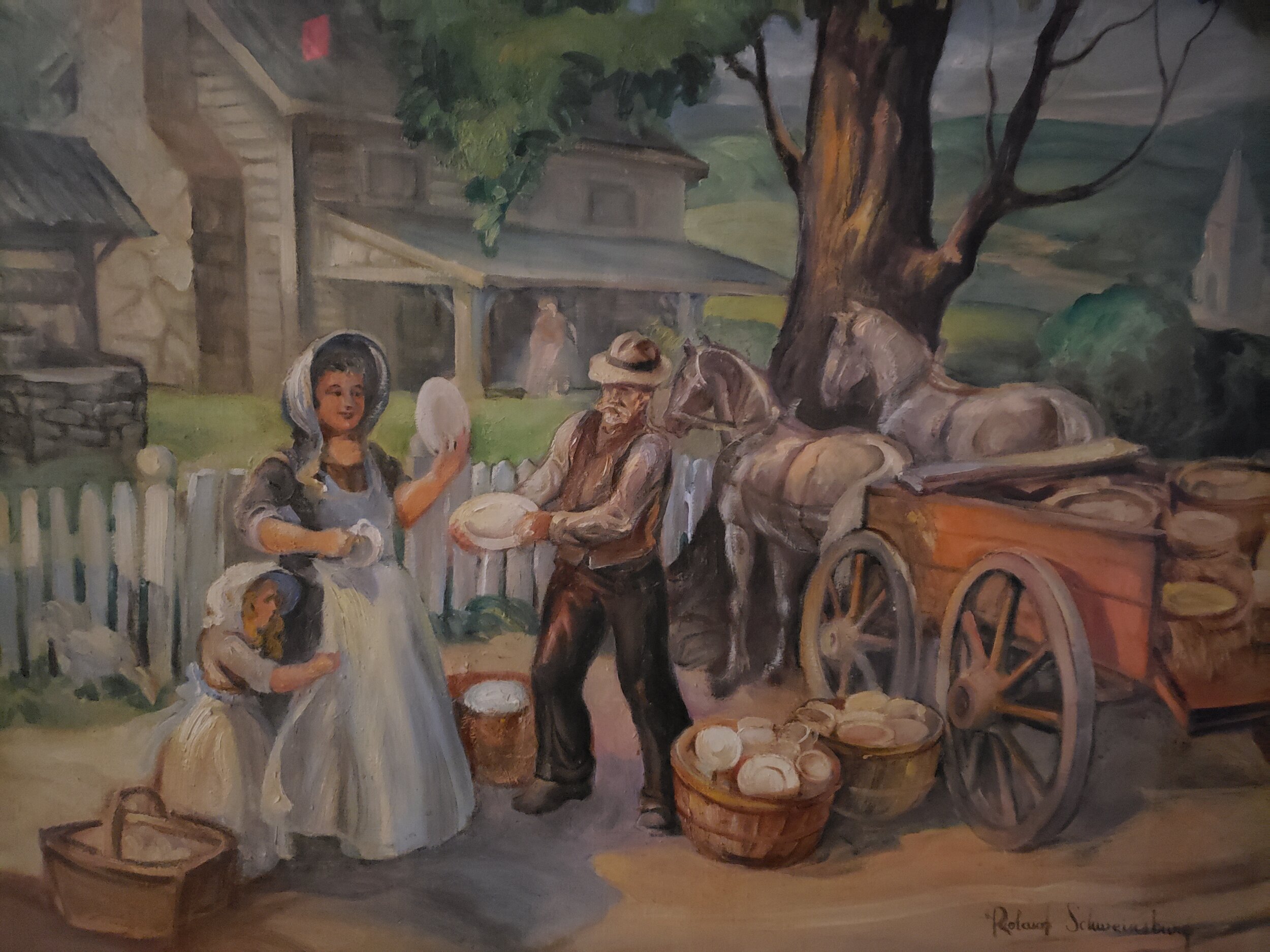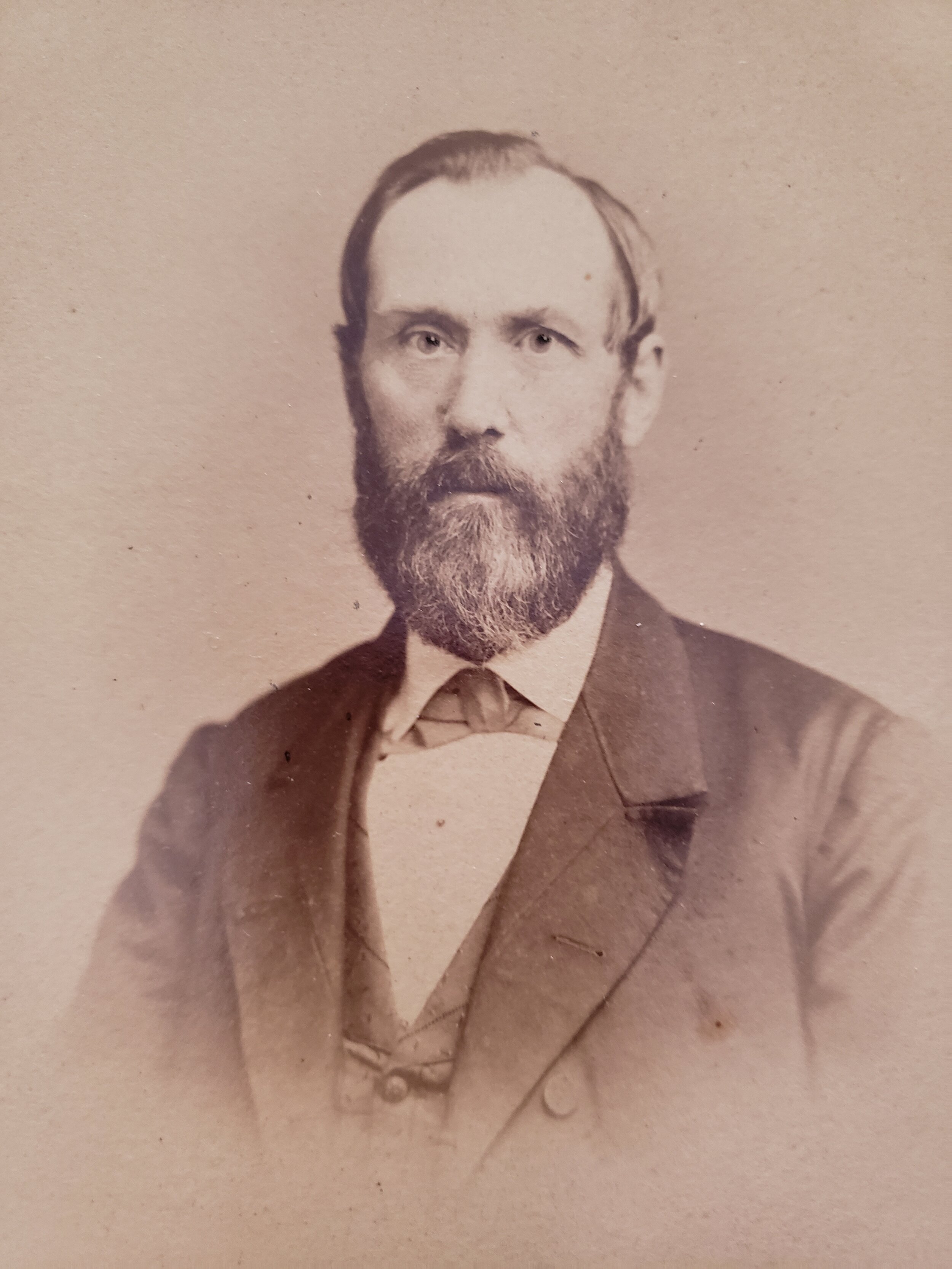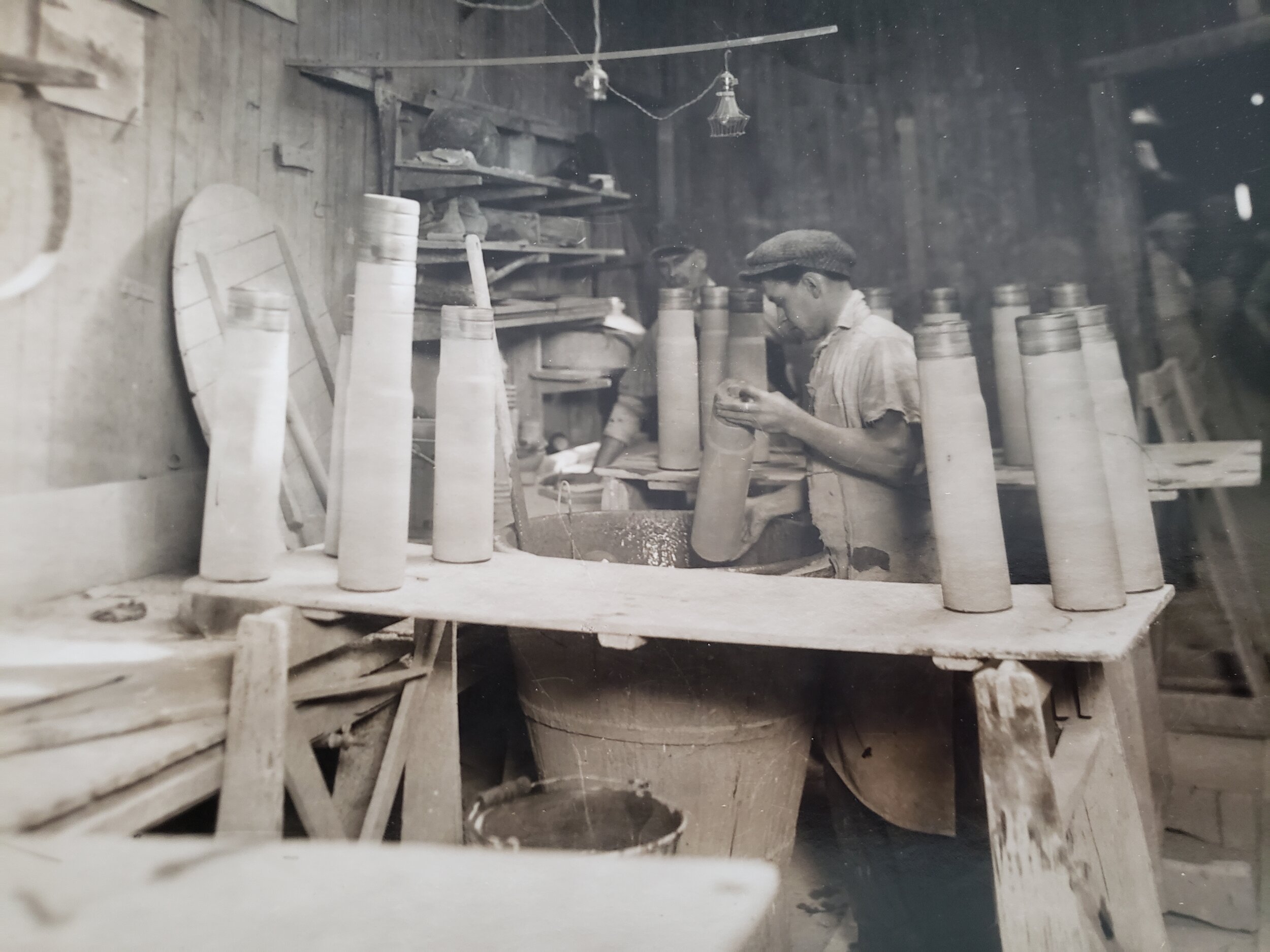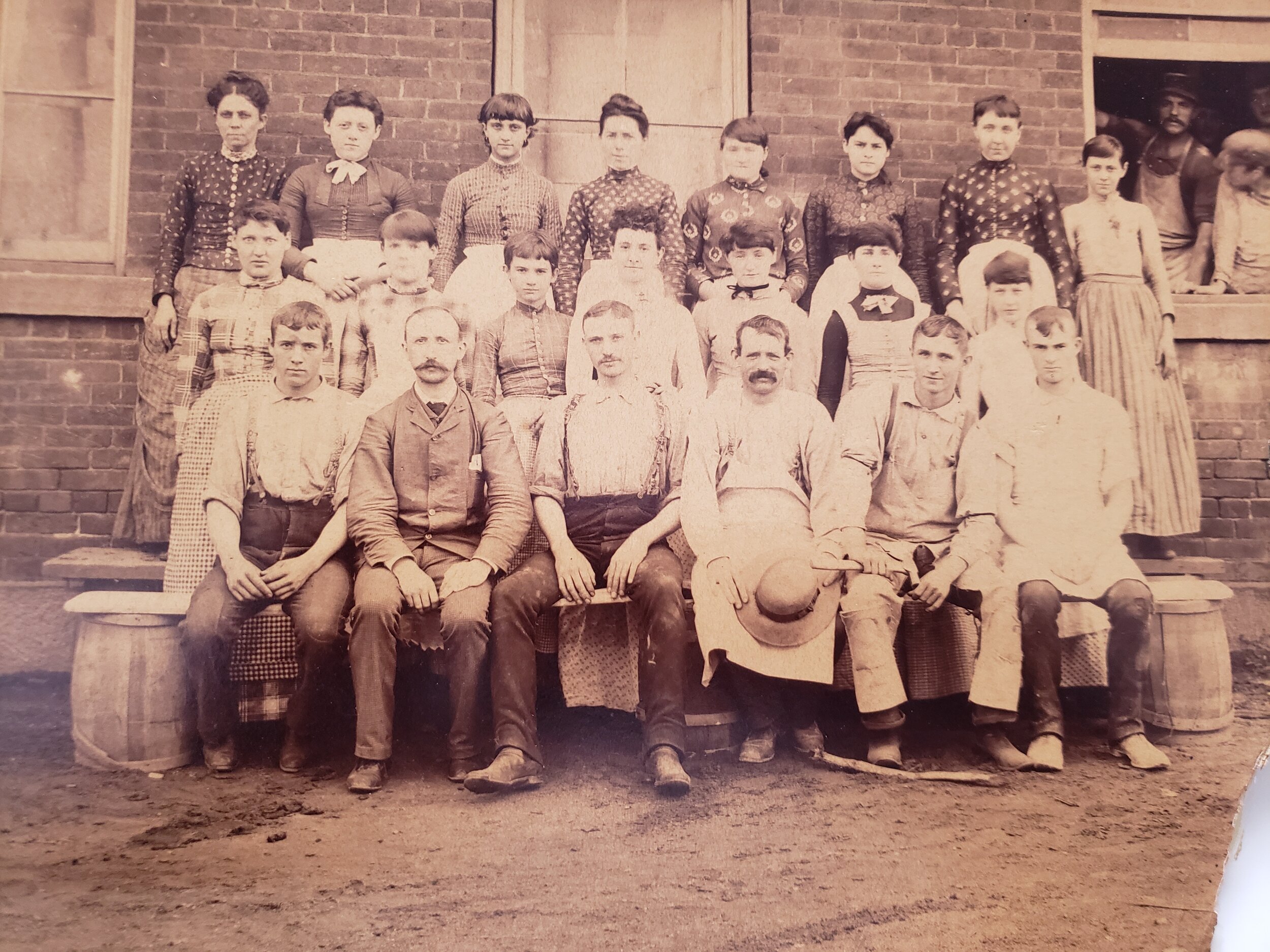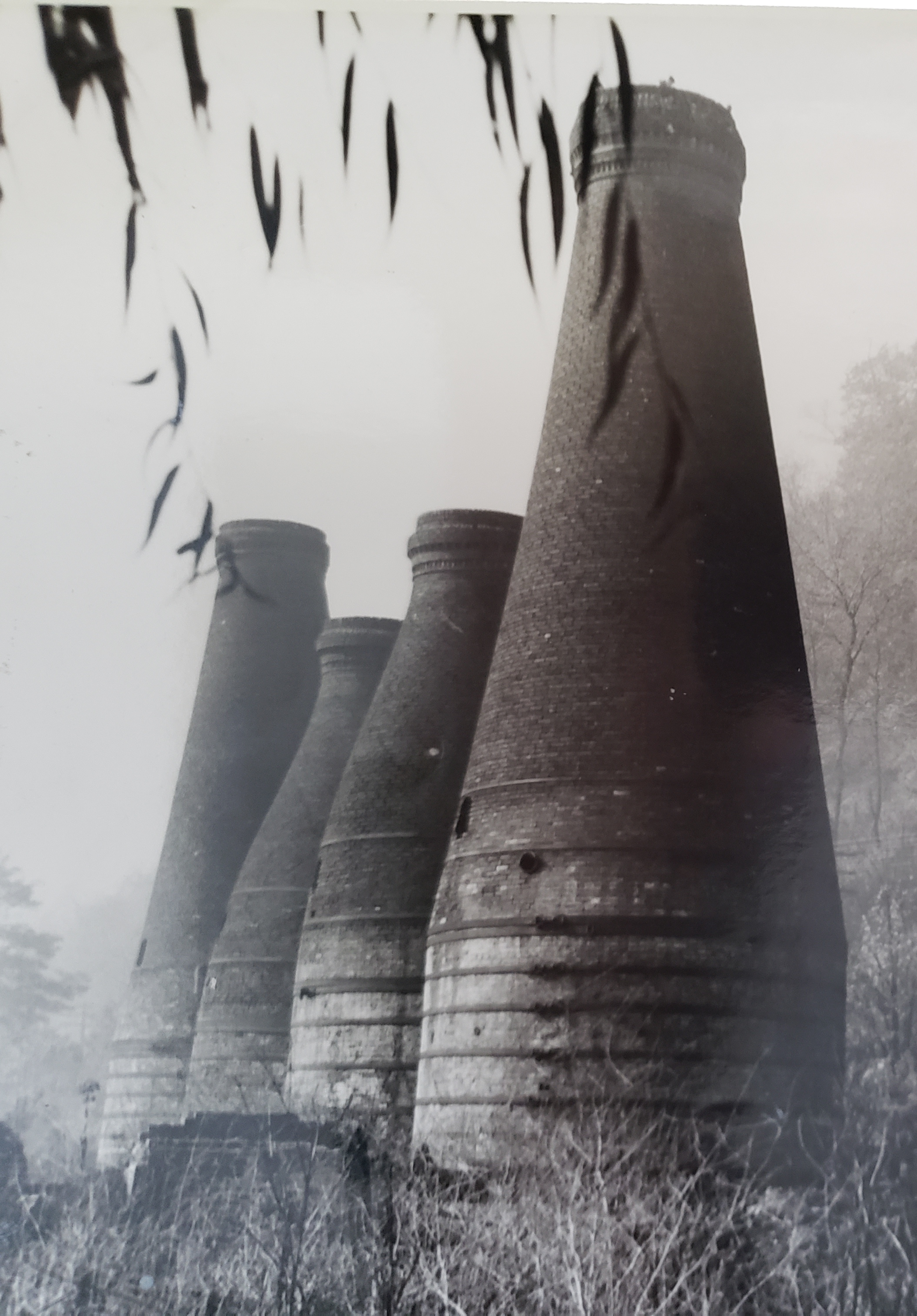
Early Potters, Potteries and their wares
Painting of Bennett’s Pottery by Roland Schweinsburg. Painting was created in East Liverpool’s Post Office, now the Museum of Ceramics, as part of the WPA artist’s program.
Early American Potters and Potteries in East Liverpool
James Bennett is the first English potter to build a commercial pottery in East Liverpool. His small, one-kiln pottery along the Ohio River was the earliest between Pittsburgh and points west. It is acknowledged that there were other potteries in the area. However, these small home-site potteries generally produced ware for local or personal use. Additionally, brick production, using local clays, supplied building bricks, roof and tiling materials for area families. There is some evidence that a two-story pottery in Longs Run (Calcutta) produced Rockingham and yellowware and predates the Bennett pottery by about ten years. However, this has not changed the tradition that it was James Bennett’s arrival, from an unsuccessful trip out west, that began the commercial pottery industry in the area. Perhaps inspired by his trip through the American frontier and by his conversations with locals about the natural clays in the area, James Bennett realized that East Liverpool was well positioned to contribute natural resources for a product that had an endless market to the west.
Bennett’s small enterprise saw immediate, moderate success. It was reported in the Centennial Edition of the East Liverpool Review that one of the first pieces produced by James Bennet from his first kiln run, was a teapot. It was presented to the recently widowed, Mrs. James Logan, in thanks for her family’s assistance in the support of the kiln and pottery construction. From that first kiln of ware, Isaac Knowles, purchased a portion and took to the river selling the ware to the communities along the Ohio River as far south as New Orleans. Bennett remained in the local area selling to the communities close to East Liverpool. It is also believed that Bennett, after firing a sufficient amount of ware, would close the pottery and travel the Ohio River selling his products and then return to make more.
There is one commonly stated Bennett accolade that is simply not true. Many historians have credited Bennett with making the first Rockingham ware in the United States. Even Edwin Atlee Barber, in his classic work “The Pottery and Porcelain of the United States," (1893) credits the Bennett brothers with making the first Rockingham. Yet it is known that Orcutt and Thompson of Poughkeepsie, New York and the Salamander Works of New York City were making Rockingham as early as the 1830s. Even the Longs Run pottery mentioned above was producing Rockingham in the 1830s. Jane Perkins Claney in “Rockingham Ware In American Culture, 1830-1930” (2004) provides an explanation: James Bennett was the first US potter to “call” his brown glazed ware, Rockingham! Others may have produced it first but Bennett was the first to market it as “Rockingham.”
Bennett returned to England to enlist his brothers in what he could see would be a profitable venture. In 1841 his brothers, Edwin, Daniel, and William along with Edward Tunnicliff arrived in the area. The Bennett’s would abandon East Liverpool less than four years later. In 1844, they left the community and industry that they had started, for Pittsburgh and later Baltimore, to establish potteries. They believed that transportation and a greater density of population toward the East was better for marketing their goods and for-profit return.
James Bennett, from Derbyshire, England may have been the first English potter in East Liverpool but he would not be the last. He and his brothers were the first of a long succession of skilled potters who would migrate from the pottery centers in Derbyshire and Staffordshire, England to the clay and coal rich area of East Liverpool, Ohio on the American frontier. It was these skilled potters that would establish East Liverpool as the “Crockery City” and the “Pottery Capital of the World.” Their skills, often received at the side of master potters such as Josiah Wedgwood, along with others, who were skilled in business and design would propel American ceramics from unknown, and of poor standing, to World recognized, and often, proclaimed as the best in the World.
The Early Salesman by Roland Schweinsberg, Museum of Ceramics collection
By 1844 there were already other potteries operating in the area. Benjamin Harker opened a pottery on his property along the river east of the city in 1842. Harker had arrived in 1839 in search of an area to farm and raise his family. He would hire a local potter to train his sons in the skills of pottery making. Although the tutelage was short lived the Harker brothers persevered in the industry and at one time the Harker pottery was the longest continuously running in the country.
Other early transplants to East Liverpool included but are not limited to, John Goodwin (1842), Jabez Vodrey (1847), William Bloor (1849), William Brunt Sr (1849), and Thomas Croxall (1844). During the second half of the 19th Century a steady stream of English, and German, potters would arrive in America looking for a way to establish themselves as master potters. They would establish centers for the pottery industry in East Liverpool, Ohio; Trenton, New Jersey, and other locations. East Liverpool was located on the American frontier giving it the advantage of selling to the West, North and South along the Ohio river and across the canals and railroads. As the East Liverpool pottery industry established the quality and scale of the wares Americans could produce the centers to the East became stronger.
Frederick Mear
James Bennett
Jabez Vodrey
William Bloor
James Salt and Frederick Mears ran a pottery in East Liverpool as early as 1842, having purchased a large building known as the “Mansion House” for the production of Rockingham and yellowware. The Museum of Ceramics exhibits a “great wheel” used in the Salt & Mear pottery. This potters wheel is only one of six extant wheels and is the largest and best preserved of the six.
John Goodwin arrived in 1842 and initially worked for Bennett and Harker. In 1844 he started his own pottery called the Eagle Pottery making an extensive line of Rockingham and yellowware. A portion of this pottery, although unused, still exists today.
William Bloor had worked at the D. & J. Henderson Pottery in Jersey City. By 1849 he was making Rockingham and yellowware with William Brunt, Sr., in Brunt’s East Liverpool pottery. Bloor would leave East Liverpool to work in Trenton until 1859 when he then returned to East Liverpool. He purchased part of the Phoenix Pottery and made the city’s first ironstone ware, as well as Rockingham and yellowware. By 1861 he had established the East Liverpool Porcelain works, making fine porcelain and parian ware, another first for the region.
Jabez Vodrey and his family arrived in East Liverpool in 1849 via several other locations. In 1848 he had started his first pottery in partnership with a local farmer, William Woodward. Tragedy struck when the pottery was destroyed by a fire. Undeterred he rebuilt the pottery calling it the Phoenix pottery. The pottery produced Rockingham, yellowware and terra cotta tiles. By 1857 William, James and John Vodrey, sons of Jabez, had opened their own pottery in an old abandoned Catholic Church calling it the Palissy Works. Jabez died in 1861 and John was killed in the American Civil War. The Company of Vodrey and Brother would remain in business until 1928.
William Brunt Sr. organized a pottery in East Liverpool in 1848 in partnership with his son-in-law, William Bloor. Their focus of production was Rockingham and yellowware but by 1850 they were exclusively making ceramic door knobs. The plant, known as the Riverside Knob Works, became the largest producer of door and furniture knobs in the country. In 1859, William Brunt Jr. would strike out on his own, purchasing a part of the Phoenix pottery and successfully producing yellowware and Rockingham.
Thomas Croxall arrived in America in 1844 and upon seeing the potential for potters in East Liverpool he immediately sent for his father and younger brothers. They purchased James Bennett’s old pottery and began producing Rockingham and yellowware. Sadly, in 1852, the pottery was destroyed by flood, a common hazard for the potteries along the Ohio riverbank.
These are just a few of the potters who would become successful in East Liverpool. Some, like the pottery of Ball and Morris, established in 1846 but destroyed by fire in 1849 were fleeting and have left little record of potters or pottery. Circumstances made owners and potters move on after financial or other disasters.
William Brunt Sr.
The early yellowware and Rockingham potteries were established in the United States primarily by Staffordshire and Derbyshire potters who had learned their trade before immigrating to America. Many were master potters and modelers, whose serviceable wares were widely used throughout the United States for the better part of the nineteenth century while others were pottery workers who had aspirations of becoming more than they were deemed in their English potteries. Many, on arriving in America had little capital and needed investors to help them build and establish their business. As the pottery industry expanded more local investors would support, and profit, from these ventures. Isaac Knowles, a local cabinet maker and Isaac Harvey are examples of local businessmen who financed pottery ventures, hiring many of the skilled and unskilled potters for their potteries. From these partnerships developed some of the most successful potteries in the World.
The East Liverpool Pottery industry would continue to expand through the 19th Century and into the first quarter of the 20th Century. The pioneers would struggle through the ups and downs of a volatile economy, the Civil War, fires and floods, with dedicated perseverance to an industry and a country they had made their own.

Early Ware in East Liverpool
Yellowware and Rockingham
American Rockingham is a type of pottery, generally with a yellow clay body, that is covered in a brown manganese glaze. It was originally developed at the Swinton Pottery, on the estate of the Marquess of Rockingham, in England. James Bennett, along with other early East Liverpool potters, used local clay to manufacture yellowware and Rockingham.
Yellowware is earthenware made from native yellow clay and covered with a clear lead-based glaze. The potteries produced wares such as baking vessels, and sanitary items for household use. Rockingham ware was a yellowware product that was coated instead with a brown manganese glaze. Yellowware was a less expensive product to produce and was also less durable. Rockingham became popular. One of the more popular Rockingham wares was the Rebekah at the Well teapot.
Edwin Bennett, who claimed to make the first Rebekah at the Well was the younger brother of James Bennett. It is strongly believed that Bennett’s designer, Charles Coxon copied the English “Arabian” motif from an English Rockingham pitcher and called it Rebekah at the Well. American potters found the Rebekah at the Well teapot a much better seller than the pitcher. Arthur Goldberg states that, “Although the Americans applied the glaze in a uniform overall fashion like the English, their techniques varied in many ways, including the amount of glaze used and the contrasting patterns employed to create something new and beautiful. The glaze was dabbed, spattered, or dripped in long, spreading streaks down the vessel’s side. Thinner coatings produced shadows outlining the molded designs and highlights to contrast or reveal the underlying yellow clay.” WJA
Bibliography:
“An Artisan Industry Supports the City: From Crude Beginnings Great Factories Have Grown and the World Acknowledges
East Liverpool's Supremacy in Pottery Production by Limitless Purchase of Our Wares.” East Liverpool Review, October 6, 1934, sec. D, 1-7.
Claney, Jane Perkins. Rockingham Ware in American Culture, 1830-1930: Reading Historical Artifacts. Hanover: University Press of New England, 2004.
Cox, Lucille T. “Adding a Page to History.” East Liverpool Review, December 16, 1938.
Goldberg, Arthur F. “Highlights in the Development of the Rockingham and Yellow Ware Industry in the United States -
A Brief Review with Representative Examples.” Chipstone. Ceramics in America 2003, 2003.
http://www.chipstone.org/article.php/76/Ceramics-in-America-2003/?s=east+liverpool+potteries.
